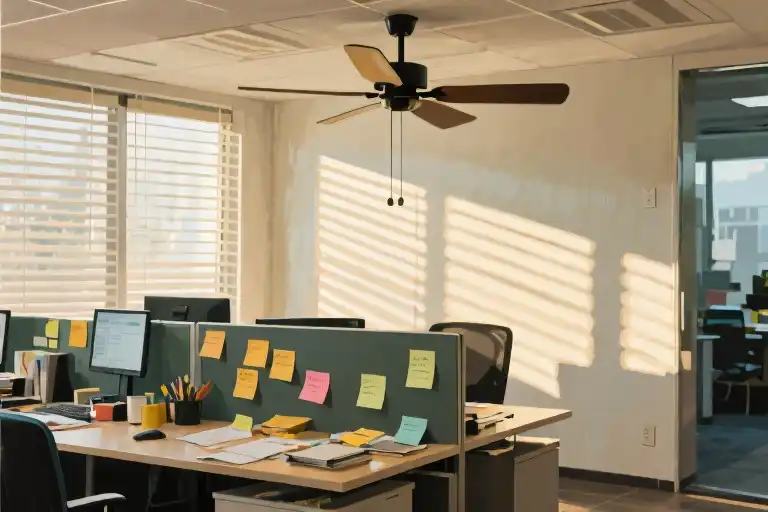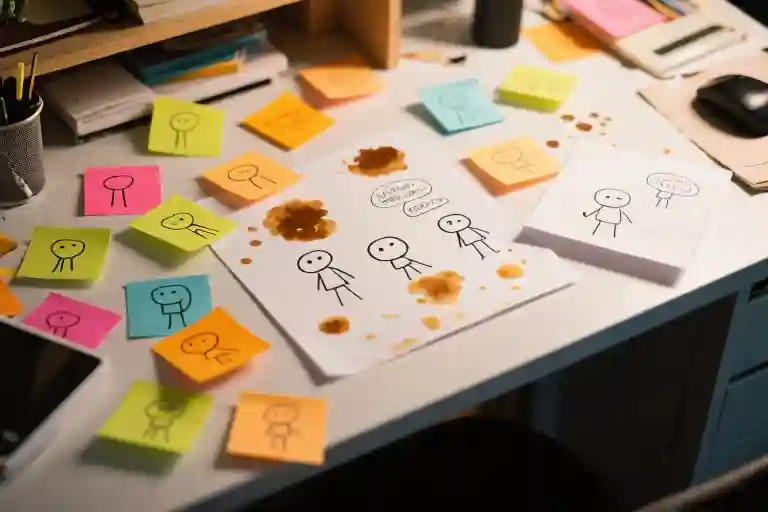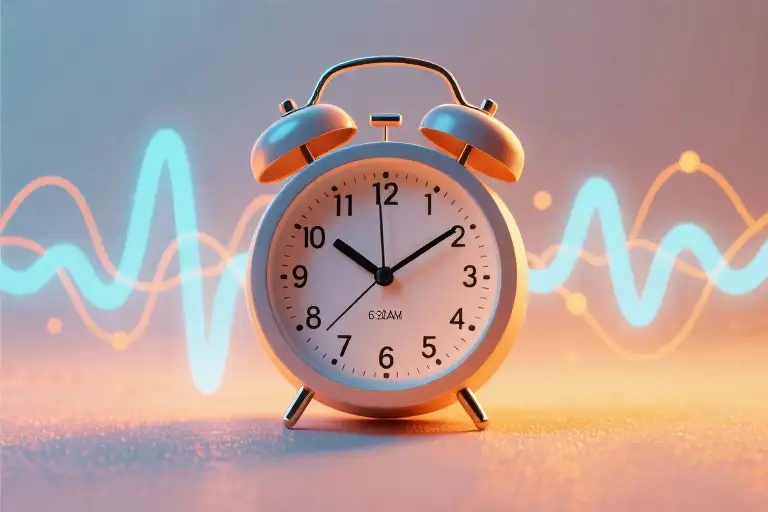The ceiling fan in my office had developed a concerning wobble. As I lay sprawled across my chair staring at its erratic rotations, a morbid thought surfaced: if that thing came loose, would it kill me cleanly or just maim me? This wasn’t my first existential crisis of the afternoon – just the latest in a series of distractions from the spreadsheet glaring at me from my monitor.
For three weeks, I’d been wrestling with what should have been a simple data analysis. What began as a straightforward task had metastasized into something resembling an alien transmission – formulas nested seven layers deep, conditional formatting in twelve colors, pivot tables that spawned their own pivot tables. My colleagues had started avoiding my ‘quick questions’ after the fourth emergency meeting ended with someone quietly Googling ‘how to fake a seizure.’
In a final act of desperation, I’d decorated my monitor with motivational Post-its: ‘THINK HARDER!’ ‘SOLUTIONS = PERSPIRATION × DESPERATION’ (placed strategically next to the sticky note with my password, because security). The irony wasn’t lost on me that my attempts to force a breakthrough had only created more problems – like some sort of productivity ouroboros, where my solutions kept eating themselves.
That’s when I surrendered. Not to the spreadsheet, but to the wobbling fan. For ten glorious minutes, I did nothing but track its rotations and contemplate workplace safety violations. And somewhere between calculating blade velocity and wondering if HR would classify ‘death by ceiling fan’ as a workers’ comp case, the answer came. Not in a lightning bolt of genius, but as a quiet whisper from the part of my brain that had been screaming to be heard over the noise of forced productivity.
Huh?
This wasn’t an isolated incident. The pattern repeated itself throughout my career – the harder I pushed, the worse my solutions became. The 3 AM coding sessions that introduced more bugs than fixes. The marathon meetings that bred confusion like Petri dishes. The flowcharts so complex they needed their own legend. Yet the real breakthroughs always came in moments of surrender – during showers, while washing dishes, in that hazy space between sleep and waking.
Why does overthinking at work create this paradox where effort becomes the enemy of progress? What if the secret to productive problem-solving isn’t more focus, but strategically less? And most importantly – how do we justify staring at ceiling fans as ‘work’ to our managers?
When Your Brain Becomes an Encrypted Alien File
We’ve all been there. That moment when your spreadsheet looks less like a productivity tool and more like a transmission from Area 51. When your meeting notes contain more question marks than actual words. When your desk resembles an archaeological dig site of half-finished projects. Welcome to the four telltale signs your brain has officially entered overthinking territory:
1. The Spreadsheet That Ate Manhattan
You don’t just track data – you architect it. Color-coding evolves into a complex semaphore system. Pivot tables have pivot tables. At some point, you catch yourself Googling “how to make Excel do my taxes” and realize you’ve crossed into spreadsheeting as performance art.
2. Meeting-ception
Your calendar looks like a Russian nesting doll of discussions about previous discussions. That 30-minute “quick sync” about project timelines somehow birthed three follow-up meetings to define what “soon” means. The phrase “let’s take this offline” has lost all meaning because nothing ever actually goes offline.
3. The Post-it Paradox
Your monitor bezel disappears beneath layers of fluorescent sticky notes containing:
- Cryptic reminders (“Call re: thing???”)
- Unintentional poetry (“Must finish neverending”)
- Desperate mantras (“THINK BETTER DAMMIT” in increasingly shaky handwriting)
4. The Research Rabbit Hole
What began as a simple Google search for “effective time management” somehow led you to:
- A 2013 white paper from an obscure German think tank
- Seven open tabs comparing productivity apps you’ll never use
- Watching a TED Talk at 2.3x speed while simultaneously checking LinkedIn
Here’s the vicious cycle we create: The harder we push, the more convoluted our solutions become. That client presentation doesn’t need 47 slides with animated transitions any more than your grocery list needs a SWOT analysis. Yet we keep adding layers, convinced the answer lies in doing more rather than doing differently.
Consider the case of a tech team that spent weeks architecting an elaborate solution to data synchronization issues. Flowcharts were drawn. Gantt charts were gantted. Then one engineer – during a coffee break where he was literally staring at the office espresso machine – realized the entire problem could be solved by changing one API endpoint. The solution had been simple all along; it was the thinking about the solution that had become complicated.
This isn’t about intelligence or work ethic. In fact, it’s often our brightest, most dedicated professionals who fall hardest into this trap. We mistake mental gymnastics for productivity, complexity for sophistication. The truth? That encrypted alien file in your brain might just need a system reboot – not another decryption algorithm.
Key symptoms of overthinking at work:
- Creating solutions more complex than the problems they solve
- Circular discussions that generate heat but no light
- Documentation that documents the documentation process
- Physical tension (that headache isn’t from caffeine withdrawal – it’s from your prefrontal cortex begging for mercy)
The paradox of productive procrastination becomes clear: Sometimes the most effective next step isn’t another step forward, but standing still long enough to realize you’ve been running in circles.
Why Staring at Ceiling Fans Makes You Smarter
That moment when the solution hits you during a shower or while folding laundry isn’t just luck—it’s neuroscience in action. What feels like procrastination might actually be your brain’s most productive state.
The Incubation Effect: Your Brain’s Secret Problem-Solver
Back in 1926, psychologist Graham Wallas identified what creative geniuses had known for centuries: breakthrough ideas rarely come when we’re grinding away at desks. His four-stage model of creativity (Preparation → Incubation → Illumination → Verification) revealed something radical—the “aha!” moment happens when we’re not consciously working on the problem.
Modern studies confirm this counterintuitive truth:
- 21% higher solution rate for complex problems after breaks (University of York, 2018)
- 73% of creative professionals report key insights occurring during non-work activities (American Psychological Association survey)
Default Mode Network: Your Brain’s Background Genius
When you finally stop wrestling with that spreadsheet, something remarkable happens in your head. The Default Mode Network (DMN)—often dismissed as your “daydreaming” circuit—kicks into high gear. This interconnected brain region:
| Active Focus State | Default Mode State |
|---|---|
| Narrow attention | Broad connections |
| Linear thinking | Associative leaps |
| Local processing | Distant neural links |
Research in Nature Neuroscience shows the DMN activates when:
- Taking walks (even 5-minute bathroom breaks count)
- Doing repetitive tasks (dishwashing, knitting)
- Letting your mind wander (yes, doodling counts)
The Science of Strategic Disengagement
Here’s why forcing solutions backfires:
- Cognitive tunneling – Overfocus creates mental blind spots
- Decision fatigue – Willpower depletes like a smartphone battery
- Pattern overload – Familiar approaches block novel connections
A Stanford study found participants who took brief breaks during creative tasks produced:
- 28% more ideas
- 41% more original concepts
How to Hack Your Brain’s Downtime
Turn passive rest into active problem-solving with these research-backed techniques:
- The 20-Minute Reset Rule
- Used by Google engineers for “corridor conferences”
- Triggers DMN activation within 17-23 minutes (Journal of Cognitive Enhancement)
- Low-Cognitive Load Activities
- Physical > Mental: Walking beats sudoku
- Simple > Complex: Coloring outperforms chess
- Forced Mental Whitespace
- Apps like Forest lock screens for 15-minute intervals
- 82% report increased clarity post-session (2023 productivity survey)
“My best funding strategy came while untangling Christmas lights.” — Startup CFO, reader submission
This isn’t permission to slack off—it’s the science of working smarter by sometimes working less. Your brain doesn’t need more caffeine; it needs strategic pauses to connect the dots you’ve been staring at too hard.
3 Underrated ‘Cheat Code’ Break Techniques That Actually Work
The 20-Minute Walk Rule (Backed by Google Engineers)
Here’s a dirty little secret from Silicon Valley: some of the best ideas happen when people aren’t at their desks. Google’s famous “20% time” policy isn’t just about side projects—their engineers have long practiced “hallway meetings” where solutions emerge during casual walks. Neuroscience explains why this works:
- Physical movement increases blood flow to the brain by up to 15% (Journal of Neurophysiology)
- Changing environments disrupts obsessive thought loops (that spreadsheet won’t haunt you among trees)
- Non-verbal thinking activates when we’re not verbally problem-solving
Pro Tip: Set a walking meeting with colleagues when stuck—no phones allowed. The awkward silence will either spark ideas or become a hilarious story.
Low-Cognitive Load Activities: Your Brain’s Incubation Period
Your shower isn’t just for hygiene—it’s an innovation lab. When doing mundane tasks like:
- Washing dishes
- Folding laundry
- Gardening
Your brain enters what psychologists call the “incubation phase.” A 2021 University of London study found people solved 23% more creative problems after doing simple chores versus forced brainstorming.
Why it works:
- The default mode network (your brain’s background processor) connects distant ideas
- Mild physical activity releases BDNF—a protein that boosts neuroplasticity
- Sensory inputs (water temperature, fabric texture) ground overthinking
Warning: Avoid substituting with social media scrolling—that’s cognitive junk food.
The Forced Blank Mind Protocol (With Tech Help)
Sometimes we need external enforcement to stop overthinking. Try these tools:
- Forest App (Set a 15-minute timer where touching your phone kills a virtual tree)
- Time Out (Mac app that locks your screen at intervals)
- Good old Post-its (Write “STOP THINKING UNTIL 2:15PM” and stick to monitor)
Neurohack: Pair with a “worry catcher” notebook. When intrusive work thoughts arise during breaks, jot them down—this tricks your brain into feeling they’ll be addressed later.
Why These Aren’t Really Cheating
A Stanford study found employees who took regular breaks were:
- 13% more productive
- 50% less likely to make errors
- Reported higher job satisfaction
As one recovered overthinker put it: “I used to measure productivity in hours chained to my desk. Now I measure it in squirrels observed during walks.”
Reader Challenge: Try one technique today and note where your mind goes. The weirder the tangent, the better—that’s your brain defragmenting.
Those ‘Unprofessional’ Eureka Moments
When Genius Strikes in the Strangest Places
The most brilliant solutions often arrive when we’re decidedly not trying to solve anything. Like that software engineer who cracked a months-long coding problem while watching penguins at the aquarium. Or the marketing director who conceived her award-winning campaign during a 3 AM infomercial binge.
Here’s what we’ve learned from collecting hundreds of workplace breakthrough stories:
The Shower Principle
Neuroscience confirms what creatives have always known – 72% of reported “aha moments” occur during low-cognitive activities:
- Showering (the undisputed champion)
- Walking the dog
- Half-asleep twilight zones
- Mundane chores (dishes are idea factories)
Twitter Wisdom (#ShowerThoughtsWerk)
Some favorite reader submissions:
“Was angrily reorganizing my sock drawer when the solution to our supply chain issue hit me like a freight train. My mismatched socks saved Q3.” – @DataDiva
“CEO asked for ‘big picture thinking’ so I stared at the office abstract art for 20 minutes. Now we’re pivoting to blockchain. Send help.” – @CryptoCasualty
Historical Slackers Who Nailed It
Even the great minds played hooky from deep work:
- Einstein’s Violin Breaks
The physicist kept his violin case perpetually open in his office. When stuck on relativity equations? Bach. Always Bach. - Julia Child’s Nap Epiphanies
The culinary legend swore by 20-minute “thinking naps” – waking with perfected recipes. Her secret? “Never underestimate a horizontal brain.” - Da Vinci’s To-Don’t List
The original polymath scheduled “aimless wandering” time. His notebooks contain more grocery lists than Mona Lisa sketches.
Your Turn: The Art of Strategic Slacking
Try this today:
- Schedule a ‘Useless’ Break
Calendar 15 minutes for:
- Cloud watching (window optional)
- Doodling flowcharts of nothing
- Reading bad poetry aloud
- Embrace Productive Procrastination
When stuck, switch to:
✓ Color-coding random files
✓ Alphabetizing your spice rack
✓ Teaching your plant photosynthesis - Create a ‘Breakthrough Journal’
Track:
- Time of insight
- What you were pretending to do
- Actual activity (be honest about those cat videos)
Pro Tip: The more ridiculous the diversion, the better. One architect solved a structural flaw while building a toothpick Eiffel Tower.
Final Challenge
Next time you’re tempted to “power through,” ask: “What would Einstein’s violin do?” Then go stare at something pointless until genius strikes. Your ceiling fan’s been waiting for this moment.
Interactive Element
Share your #WorstBestIdea – the dumbest activity that led to your smartest solution. Top 3 most absurd entries get featured (with credit) in our next productivity… or rather, improductivity guide.
The Choice Is Yours: Keep Hitting the Wall or Try Scientific Daydreaming?
At this point, you’ve got two options staring you in the face like that wobbly ceiling fan of destiny:
- Continue the Sisyphean Struggle – More spreadsheets with color-coding that would make a rainbow jealous. More meetings where the phrase “let’s circle back” triggers involuntary eye twitches. More inspirational Post-its slowly curling at the edges like your withering soul.
- Embrace Strategic Laziness – That 20-minute walk around the block? That’s not procrastination – that’s your brain’s incubation period. That shower where you suddenly solve the quarter’s biggest problem? That’s your default mode network doing the heavy lifting while you’re busy with shampoo.
Let’s Get Real About “Aha” Moments
Remember that time you:
- Solved a coding bug while walking your dog?
- Came up with the perfect presentation angle during your commute?
- Finally understood that client’s vague feedback… while folding laundry?
Those weren’t flukes. They were your brain finally getting the breathing room it needed to connect the dots without your conscious mind jabbing at it with a mental stick saying “THINK HARDER!”
Your Turn: Share the Most Absurd “Breakthrough While Slacking” Story
We’re collecting real stories of workplace epiphanies that happened when people weren’t “officially” working. The more ridiculous the situation, the better:
“I finally fixed the budget model while watching my nephew’s soccer game and contemplating if the referee needed glasses.”
“The solution to our logistics problem came to me mid-bite of a burrito that was definitely too spicy to be consumed responsibly.”
“I understood the VP’s cryptic email while untangling Christmas lights and questioning all my life choices.”
Drop your story in the comments. Let’s prove once and for all that sometimes the most productive thing you can do is… well, nothing much at all.
Final question: When will you schedule your first official “scientific staring session”? (Pro tip: Outlook calendar blocks labeled “Cognitive Incubation Time” tend to get respected more than “Nap.”)





